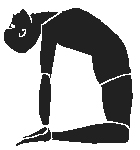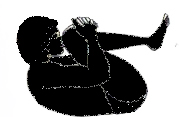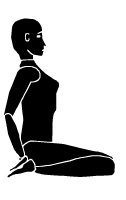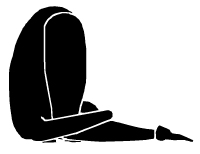Introduction

About 10% of the adult male population will suffer from hernia at some period during life time. The incidence of inguinal hernia's more in males and incisional/ umblical hernias is more common in females. Symptoms of hernias vary, depending on the cause and the structures involved. Most begin as small, hardly noticeable breakthroughs. At first, they may be soft lumps under the skin, a little larger than a marble; there usually is no pain. Gradually, the pressure of the internal contents against the weak wall increases, and the size of the lump increases. Early on, the hernia may be reducible - the protruding structures can be pushed back gently into their normal places. If those structures, however, cannot be returned to their normal locations through manipulation, the hernia is said to be irreducible, or incarcerated.
Yoga and Hernia
Energizing Yoga, the oldest system of personal development needs no introduction nowadays and is becoming popular all over the world because of its tremendous physical and medical benefits. Yoga is a way of life, an art of righteous living or an integrated system for the benefit of the body, mind and inner spirit. This art originated, was perfected and practiced in India thousands of years ago. The basic idea of yoga is to unite the atma or individual soul with the paramatma or the Universal Soul. According to Yoga philosophy, by cleansing one's mind and controlling one's thought processes one can return to that primeval state, when the individual self was nothing but a part of the Divine Self.Prevention is better than cure and yoga and exercise are the best way to keep ourself fit. Today, interest in heath consciousness is attracting people from all over the world to earn better health in body and contentment in mind. The practice of yoga keeps our mind, body and spirit fit and fine and energize us to fight against all odds in all condition. Yoga is said to be beneficial for people with hernia or those who have a tendency to develop hernia. Yoga postures, when done correctly under the guidance of an expert, can prevent as well as cure hernia. Yoga is gaining popularity all across the world because of the health as well as medical benefits of this form of exercise. Yoga is said to prevent and cure several health problems. There are also specific asanas which help hernia patients.
YOGA POSES FOR HERNIA
Bow Pose
The alternating stretching and releasing of the abdominal muscles increases blood flow to this area and aids all sorts of digestive disorders and discomforts. The Bow works all parts of your back simultaneously. The pose is so named because as you hold it, your body is bent back like a bow and your arms are held straight and taut like a bowstring.Camel Pose
The camel pose is a powerful posture for stretching the spine, back muscles, shoulders and arms. It is best to practice it later in your asana routine after most of the muscles are limber and and you have worked the back and shoulders. Compresses the spine helping to ease back & neck problems, opens the rib cage, heart, lungs & digestive system, stimulates the nervous system, great for lungs & any problem in the bronchial plexus (a bundle of 5 nerves, which control muscles in the shoulder, arm & hand), strengthens back & shoulder muscles, improves neck movement, stretches the throat, sends fresh blood to kidneys & helps to eliminate toxins.Wheel Pose
In Wheel Pose, also called Upward Bow Pose, it takes precision and breath control to release the pose. In Ashtanga yoga, right before you go into the closing sequence, you do the Wheel, aka backbend. This is one of my favorite poses because not only does it increase flexibility in your spine, but it also opens up your shoulders and strengthens your upper back and thighs.Uddiyana Bandha
Uddiyana bandha can be practiced alone or in conjunction with mula bandha.Uddiyana bandha tones, massages and cleans the abdominal organs. If you are familiar with mula bandha, you will see that the drawing up of the pelvic floor naturally leads into the drawing up of the abdomen. This is how the bandhas work together.Uddiyana" means 'flying up', and 'Bandha', means 'lock' or 'tie' in Sanskrit. Uddiyana is the 'flying up' of the diaphragm in the thorax and the simultaneous pulling back of the abdominal viscera above and below the navel towards the spine. The improved functioning of the somatic nerve helps the coordinated activity of the voluntary and involuntary nervous systems.,YOGA ASANAS FOR HERNIA
USHTRASANA

Steps
- Go down on your knees and reaching backward, grasp the left ankle with the left hand and right ankle with the right hand.
- Inhale through the nostrils and holding the heels, straighten the thighs and waist. Bend the head and neck backwards as much as you can. Push the waist area slightly forward. Breathe normally and stay in that position for 6 to 8 seconds.
- Now exhaling return to the kneeling position. Release the left hand first and straighten up the left side of the body a little. Then release the right hand and make the body straight and in the kneeling position.
PAVANMUKTASANA

Steps
- Bend the right knee and interlock the fingers.
- Keep the left leg straight on the ground.
- Inhale deeply .Holding the breath raise the head and shoulders off the ground and try to touch the right knee with the chin.
- Remain in the final posture for a few seconds.
- While slowly exhaling, return to the base position.
UTTHANPADAASANA

Steps
- Lie on the floor with your body straight. Heels should be together. Look towards the ceiling.
- Slowly inhale and take in as much as air you can.
- Holding your breathe lift both the legs up about 10 inches high from the floor. Legs should be held together straight and toes stretch forward. Retain for about 5 seconds.
- Exhale slowly and begin lowering the legs simultaneously.
- Complete exhaling by the time your legs are brought back to the floor.
SARVANGASANA

Steps
- Lie flat on the back in the shava-asana.Inhale through the nostrils. Place the palms face-down on the floor.
- Keeping the hips on the floor bend the knees and bring them up toward the stomach while exhaling.
- Inhale slowly through the nostrils, press down on the hands and lift the torso from the waist up off the floor, arching the spine backwards and straightening the arms. Keep the hips on the floor.
- Inhale, and then while exhaling, raise the legs straight up perpendicular to the floor. You may support your hips with your hands or leave the arms flat on the floor, whichever is most comfortable.
- The legs should be together with the knees straight and toes pointed straight up. Keep the head straight without turning it to either side. The chin should be pressed against the chest.
- Breath gently through the nostrils while the posture is held.
- Reverse the steps to return to the shava-asana.
VAJRAASANA

Steps
- Bend the legs backwards and sit with the help of your knees. Stretch the legs towards the back and both toes should touch each other. Keep the heels apart and let buttocks rest on heels, or let them lie in between the heels.
- The waist neck and spine should be in a straight line. Rest both your hands on the knees and keep the elbows straight. Look towards front, breathe normally.
- Initially do this asana for 15 to 30 seconds. Subsequently try to increase the duration to 3 to 5 minutes.
SHASHANKASANA

Steps
- Take a deep breath and raise both the hands in one line with head up (palms facing each other).
- Bend forward while exhaling and let the forehead touch the ground.
- Retain this position as long as you feel comfortable and come back to Vajrasana position.
- Relax for some time and repeat the asana.
Diseases Related to Virgo |
||


